Alders are chiefly grown in little woods. Planted by the side of rivers, too, their tough and creeping roots bind and support the banks. Alder-coppices are very valuable to the makers of—gunpowder! Every five or six years the little alders are cut down and burned to charcoal, and the charcoal of alder-wood is reckoned particularly good by gunpowder manufacturers.
The Aspen, or Trembling Poplar (Populus tremula), like the alder, is fond of damp situations. It has also a white soft wood, used by the turner and engraver, and for such small articles as clogs, butchers’ trays, &c, &c.
The quivering of its leaves is a favourite topic with poets, and there is a curious old Highland superstition that the Cross of Christ was made of aspen-wood, and that thenceforward the tree could never rest.
In “little woods” it may be cut every seven or eight years for faggots, and at fifteen or twenty years old for poles.
The Beech (Fagus sylvatica). With this beautiful tree all our young readers must be familiar. There may be those whose minds are not quite clear about wych-elms and sycamores, but the appearance of the beech-tree is too strongly marked to allow of any confusion on the subject.
The beech is spoken of by Greek and Roman writers, and old writers on British agriculture count it among the four timber trees indigenous to England: the beech, the oak, the ash, and the elm.
It is said, however, not to be a native of Scotland or Ireland. It attains its full growth in from sixty to eighty years, but is believed to live to be as old as two hundred. The timber is not so valuable as that of the other three British trees, but it is used for a great variety of purposes. Like the alder, it will bear the action of water well, and has thus been used for piles, flood-gates, mill-wheels, &c. It is largely used by cabinet-makers for house furniture. It is employed also by carriage-makers and turners, and for various small articles, from rolling-pins to croquet-balls. The dried leaves are used in Switzerland to fill beds with, and very nice such beds must be! Long ago they were used for this purpose in England. Evelyn says that they remain sweet and elastic for seven or eight years, by which time a straw mattress would have become hard and musty. They have a pleasant restorative scent, something like that of green tea. When we think how many poor people lie on musty mattresses, or have none at all, whilst the beech-leaves lie in the woods and go very slowly to decay, we see one more of the many instances of people remaining uncomfortable when they need not be so, because of their ignorance. The fact that beech-leaves are very slow to rot makes them useful in the garden for mulching and protecting plants from frost.




